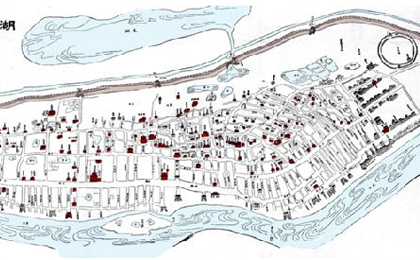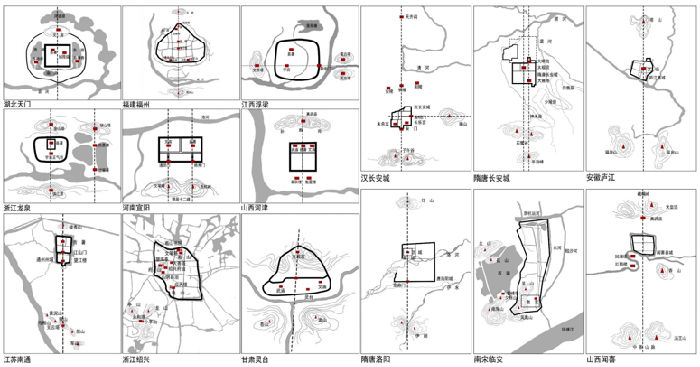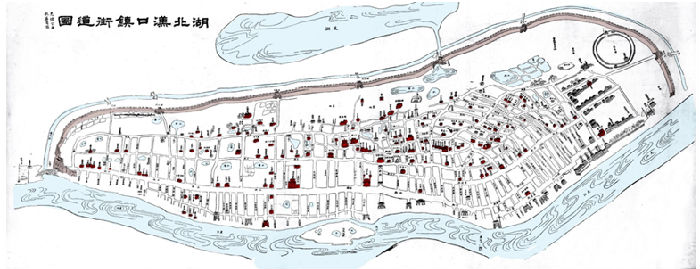


Introduction
"Planning Eureka" is an online communication activity between China and foreign countries organized by UPSC. In each issue, two top experts will present their research findings on the same topic.
On January 12th, 2021, the first issue of "Planning Eureka!" held by UPSC was launched online, with the topic of "City, Culture and Space". Professor Wang Shusheng, vice president of Xi'an University of Architecture and Technology, delivered a report entitled "Chinese Model of Urban cultural Space planning and Construction". The following is the full text of the report:
1. The Essence of Chinese Cities
I will report from three aspects. The first is the essence of Chinese cities. China is known as an ancient civilization in the world. German philosopher Karl Jaspers mentioned that in the Axial Period, civilization including ancient China gave birth to a large number of philosophers. The ideological principles they proposed shaped different cultural traditions and have always influenced human life.
Chinese civilization gave birth to China's urban system. China is a country with a vast territory, a large population and a history of thousands of years. The Chinese civilization is also the only one in the world that has continued to this day without interruption. City is the main carrier of civilization. It has formed a unique Chinese system in planning and construction ideas, principles, methods etc. Chinese culture attaches great importance to the issue of "what is human". The debate between “human and animal” by historical philosophers is to explore the essence of human beings, such as "Human is benevolent", "Human is the heart of universe". These understanding of people directly affect the planning and construction of urban settlements.
Chinese cities have the function of production and require people to gather together, which is the common foundation of all cities. Meanwhile, there are also living needs above production, that is to meet the basic function of human settlements. For traditional Chinese cities, we should further emphasize that spiritual demand is beyond production and living. That is to build cities with ideals of people according to the cultural values of the Chinese nation.
The essence of China's planning and design is to realize the objective of "human gathering", "human surviving" and "human dwelling" by coordinating the productive, living and spiritual space. Planning and construction has always put the spiritual space in a critical position, so as to lead the city's productive and living space. As a result, Chinese urban space has an inner structure and mechanism under the guidance of the idea of "human gathering, "human surviving" and "human dwelling". And the relationship between people is the basis of the existence of a city, which could be realized through various functional and emotional space. Meanwhile, the nature of each city is unique, and the premise of planning is to understand the "characteristics" of the natural environment. Furthermore, cultural values also directly affect the urban planning and construction, breeding the cultural space of the city.
In Chinese traditional culture, "Heaven and Earth" represent the unity of cultural value and regional environment, in other words, the integration of nature and culture. At the same time, Chinese cities also embody strong historical spirit and ideal pursuit, expressing people's overall consideration of history and future. From the perspective of the future, we are the history of the future, and we should integrate historical experience with future development. The “culture, nature, going and coming” represented by "heaven, earth, past and future" form the inner structure of urban planning in China. These are the foundations of cultural value, spiritual connotation and spatial characteristics of Chinese cities.
A city is always in a constant state of development and change. In other words, city develops under the joint action of its motive force and restriction factors. The dynamic and restrictive factors of the city constantly break the original balance, which requires "people" to reconcile. In this process, new balances could be formed through the adjustment of people according to certain rules, which make the city constantly pursues stability in changes. China's urban development is the unity of "change" and " invariability". Each city has established its own spatial foundation according to "heaven, earth, going and coming". In emphasizing the relationship and changes between "heaven-earth-human" as well as "past-present-future", the "urban structure of landscaping and cultural spaces (USLCS)" forms the foundation of the city, just like the " meridian and collateral" of the city. In a nutshell, the change of the city is inevitable, new contents are constantly increasing, and USLCS is also growing and innovating. It is a basic principle of China's traditional planning to protect the foundation of the city, comply with the changes of the city, and constantly achieve a new balance of urban space.
2. Historical experience of urban cultural space planning and construction in China
Under the guidance of this idea, China has formed its own traditional experience of cultural space planning and construction.
Firstly, USLCS is the foundation and soul of urban space. In accordance with the principle of "humanity priority, landscape connection and history continuity", the city and the surrounding landscape environment could be regarded as a whole. On the basis of comprehensive observation, cognition and grasp of the inherent uniqueness of natural environment, ancient planners could make the scheme of the cultural conception and spatial elements of the city. Among the important human spaces related to urban history and cultural spirit, the core cultural space is located in the crucial point of natural environment. Meanwhile, following certain organizational principles and methods, a pattern of integration of natural and cultural space order should be formed.
The following figure shows the brief spatial pattern of nature and culture in different cities.

Figure 1
Taking Chang'an (now Xi'an) as an example. Some scholars regard Chang'an as a model of mature Confucian civilization and urban structure in history. The picture on the left (Figure 2, left) shows the relationship between the urban planning of Xi'an in the past dynasties and the surrounding large-scale landscape. The key point is to make the critical cultural buildings echo with the large-scale landscape. The Chang'an City on the right (Figure 2, right) indicates that the cultural space and key elements in the city should integrate to form a whole space in accordance with the Confucian order. In particular, the Xuandu Temple and Daxingshan Temple were established on the central axis of the city with Taiji palace as the focal point. In this way, the space of Buddhism and Taoism formed by Chinese culture, which had absorbed foreign culture since the Han Dynasty, was placed in the supreme place of the city, forming critical spatial symbols of the city. Nowadays, Xi 'an still maintains this order and guides the spatial layout of the city through cultural sites, including the South Gate, the Great Wild Goose Pagoda, and the Daming Palace, etc. These historical spaces still play a critical role in people's cultural life. Taking Beijing as another example, which is called "a masterpiece of urban planning". On its 7.8 km axis, buildings and spaces with cultural significance launch the foundation of order.

Figure 2
Secondly, USLCS of a city dominates various cultural spaces to meet the mental needs of the people at different levels. Each type of cultural space occupies a certain scale and proportion of land use. Meanwhile, these spaces are classified to respond to the living requirements of "acquiring knowledge, acquiring pleasure, acquiring respect and acquiring thinking", which could be divided into six types, namely spiritual, memorial, ceremonial, recreational, religious and educational. Nowadays, Confucian temples, academies and theatres in cities still play a critical role in the cultural life of citizens.
Thirdly, the symbolic cultural space has the function of spiritual guidance and local originality. Cultural space is the individualized creation of national cultural values under specific local environment. It is interwoven with national cultural spirit and local perception of landscape, history, figures and places. The urban cultural space interprets the meaning of human life and embodies the values and cultural ideals of the city. These significant cultural ideal spaces are not only the expression of urban spirit, but also the embodiment of urban life.
In the past, the symbolic cultural space was often located in the critical position of landscape. This kind space has played an essential role as spiritual guidance during key period of national development. For instance, the Yellow Crane Tower in Wuhan, rebuilt several times in history, is still thriving and becoming an important carrier of the national spirit. During the COVID-19, the Yellow Crane Tower in Wuhan remains a significant venue for rallying and inspiring the whole city.
Fourthly, urban cultural space inherits and breeds Chinese culture. The relationship between the city and its surrounding landscape environment is recognized from people's perception. Therefore, these spaces are pregnant with people's ideology. These thoughts are not only the inheritance of Chinese history and culture, but also a kind of innovation, closely combining culture, poetry, space, city and landscape. It is in such a system that Chinese culture is conceived, inherited, innovated and developed. For instance, influenced by the famous Yueyang Tower, the spirit of " be the first to feel concern about state affairs and the last to enjoy yourself" has been widely spread.
Fifth, the urban cultural space continues to innovate and develop through inheritance. Urban development should pay attention to not only the material function and spatial form, but also the humanistic connotation of the space, so as to achieve the integration of them. Taking Hankou, Wuhan as an example, with the development of culture and economy, social problems emerged due to population gathering in the ancient Hankou. People of insight at that time believed that with the development of urban economy and the increase of population, urban cultural space should play a role in enhancing people's cohesion. As a result, funds were raised to build a college to educate the people. Similarly, in Chinese history, cultural elements have been evolving with the development of the times. Its basic mode is to meet people's needs and cultural heritage as the starting point, and to form a series of new cultural spaces afterwards. Gradually, the characteristics of the city established, and even became the symbol of the times. The figure below shows the ancient map of Hankou, in which the cultural space is marked in red (Fig 3)。 The texture of the city is obviously affected by the economy. However, even such economically prosperous cities have dense urban cultural sites.

Figure 3
3. The future of cultural space planning and construction in China
With the development of economy, Chinese cities have taken on a new look with new forms of cultural space. While inheriting history, each city carries out creation. However, in all levels of cities, there are problems in urban cultural space, including the decrease of cultural land and the disorder of cultural space. Hence, the new era requires planners to meet the needs of the masses for cultural life and to think about the construction of cultural space.
Many scholars have made beneficial explorations on this issue. As early as the 1950s, Mr. Liang Sicheng appealed that "We should not forget that architecture and urban planning are not only economic construction, but also the most important and significant part of cultural construction. They must develop in the tradition of national excellence"; In the 1980s, Mr. Wu Liangyong also called for infrastructure not only including roads, electricity etc., but also social and cultural; Mr. Zheng Xiaoxie mentioned in "Cultural Environment" that “urban cultural environment is very important”; Mr. Zhang Jinqiu proposed that every city should be recreated on the basis of its own cultural characteristics.
On this basis, we put forward the construction of the Cultural Land System (CLS)。 In order to keep the spatial gene of "heaven, earth, going and coming", it is necessary to have an innovative understanding of the cultural space system nowadays according to the principle of local planning. Based on the tradition of humanistic planning in China, the demand of human beings should be put forward. As a result, it is critical to launch CLS by establishing Cultural Land System Planning (CLSP)。
The CLSP mainly includes the orientation of urban cultural spirit, the constituent elements of Cultural Land (CL), the design of USLCS, the scale of CL, and the level of CLSP, etc.
First, every city should have a cultural and spiritual orientation. It should be clarified where the city comes from, what kind of moral spirit people should uphold, and what is the foundation of urban cultural pride and self-confidence.
Second, the composition of urban cultural elements. Our team divides CL into six categories. Category 1 is the cultural and spiritual symbolic land of each city, which include national, regional and urban levels. Such as the Yellow Emperor Mausoleum and Tian 'anmen Square, these places are the symbols of China. For those small cities, including county towns, there are also symbolic spaces with historical origins. Category 2 is commemorative land. Every city has historical figures and events worthy of commemoration, including revolutionary sites and so on. These memorial spaces could help unite people via their historical value. Category 3 is the space of religious land left in history, that is, the land needed for religious activities according to law. Category 4 is the land for cultural heritage, among which many memorial sites or religious sites themselves are also cultural heritage. Category 5 is the land for cultural facilities, which is to meet the daily cultural demands of residents. Category 6 island for cultural industry. Each city has its own history, culture and customs. Hence, it is bound to be different in the types of cultural industries. Under the premise of cultural spirit orientation, combined with the specific situation of each city, it is necessary to study the characteristic elements of each type of land from six types, and finally form the general map of cultural land.
Third, the design of USLCS. Firstly, it is essential to protect the USLCS. In the new era, planners should inherit the essence of the existing USLCS and protect the historical pattern. Meanwhile, it is necessary to construct innovative USLCS. On the basis of protection, it is critical to sort out the natural and humanistic elements that constitute the USLCS. Landscape is the natural coordinate of a city, while culture is the spiritual coordinate. Hence, planners should recognize the coordinates of nature, understand the context of the landscaping environment of the city, taking this as the framework to control the urban form, and launch the buildings with cultural significance at the key locations.
Fourth, the determination of the scale of CL. A city should not only have the pattern of cultural space, but also different levels of CL, which together constitute the proportion of CLS. The scale of CL is the basic index of urban cultural environment evaluation. The concept of "culture land rate" is introduced here to measure the basic level of urban cultural environment. It refers to the proportion of the total area of urban core cultural land to the total area of urban built-up area. We have conducted statistics on many domestic cities and found that compared with cities in similar countries, the scale of CL in China needs to be further improved.
Fifth, the hierarchy of CLSP. At the national, regional, urban and district level, there should be thinking and spatial design of CL. Meanwhile, in order to carry forward the excellent tradition of urban planning in China, it is necessary to establish standards or requirements for cultural space planning and construction.
Furthermore, planners should integrate the ideas of Chinese urban cultural construction into modern planning. Firstly, planners should excavate the planning tradition, and explore the planning ideas and methods that have long-lasting value in Chinese urban planning. Secondly, planners should fully realize that without theoretical innovation, it is challenging to make a breakthrough in practice. Only by integrating China's local planning theories and methods into the current theoretical system can we understand and judge problems with Chinese thinking and values, so as to provide Chinese wisdom and solutions for world-wide planning and construction. Thirdly, each city has its own planning tradition and experience. Planners should rediscover the planning wisdom cultivated by each city with confidence and objectivity. Finally, the revival of local planning depends on people. Planners should establish Chinese consciousness and patriotism, while planning education should attach great importance to the inheritance of local planning.
In conclusion, Chinese civilization has nurtured Chinese cities and formed a system of ideological principles and methods for local planning and construction. Nowadays, China has made great efforts to learn from western planning. And Chinese civilization has experienced the largest urbanization development in mankind, while great achievements have been made in planning and construction. Meanwhile, we are also increasingly aware of the modern value of traditional planning in China. As a result, it is critical to re-understand and summarize the current planning and construction practice with Chinese wisdom on the basis of inheriting the 5,000-year-old civilization tradition.
The original text of the report is in Chinese. According to the contents of the report, it is sorted out and posted on the official WeChat of UPSC. All figures are from the original text. Some of the contents have been adjusted in translation.